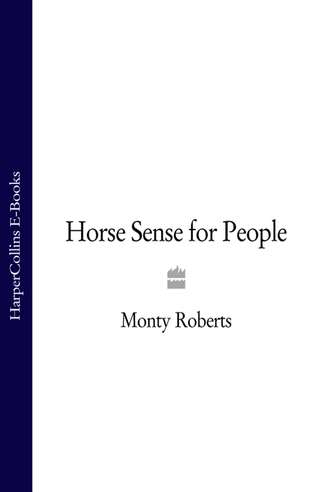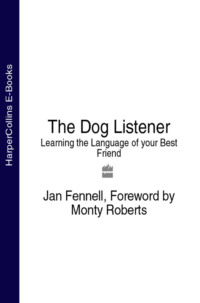
Полная версия
Horse Sense for People
A handshake might be perceived as an attack to such a child, who will often approach you from behind, just as the horse in my round pen does when I do Join-Up. Autistic children will try not to look you straight in the eye, but firm eye contact, conveying focus, plays an important part in their communication system, as does touch. Many such children want to be hugged but cannot handle the psychic distress that this stimulation causes. As with the horse a certain quality of touch is acceptable, but it must never be forced. Both will become very accustomed to seeing the outline of a person they deal with every day and will recognize familiar sounds and shapes. The horse is immediately alarmed when faced with something that has an unfamiliar shape and is liable to react with extreme fear, even spinning around and bolting. The autistic child will almost certainly fear strange sights or sounds, which can be a trigger to violent or repetitive behavior.
Perhaps it is not surprising that the horse, a visual thinker with an extraordinary ability to sense the intentions of its rider, is quite comfortable being ridden by autistics and, furthermore, is able to cope with their often unusual behavior.
My interest in autistic children is not entirely founded on the similarities they share with the horse. I also think in pictures, and perhaps this has something to do with my success in working with horses. For a long time it never occurred to me that everyone didn’t think that way. I can still remember the floor plan of a house that my grandparents lived in—each room, how the furniture was arranged and where the windows were. That house was demolished when I was eighteen months old. When it came to designing Flag Is Up Farms, I had no difficulty in planning it out because I could see the end result. It was the same with our house and the subsequent alterations and extensions that I have made.
Temple Grandin is an autistic and a well-known author of several books and articles on her unusual life and chosen area of study—the design of feed lots, slaughterhouses, corrals and farms that handle animals. I first heard about her in the mid-1990s when her book Thinking in Pictures was recommended to me. I devoured it and was awestruck by the similarities that I found when comparing her thought processes to mine. I was impressed by her ability to recognize and reduce stress levels in cattle being handled in chutes. She used her special ability as an autistic with a pictorial memory to determine factors that terrified the cattle. She is now designing handling facilities for animals by employing concepts that would have been considered foolish and unnecessary just a couple of decades ago.
Temple Grandin has revolutionized the way in which cattle are brought to slaughter. Her autism means that she finds it difficult to cope with being touched and she fears loud and sudden noises, just as cattle do. So she brought a particular insight and sensibility to the problem of avoiding panic in cattle at stockyards. Her solution was simple, but brilliant: have the cattle follow a circular path, since moving in circles is in their nature and comforts them.
Though seemingly cut off from the world, the autistic may have lessons to offer us. The ways of her fellow humans confound Temple Grandin but she saw something terribly lacking in the way we handle animals destined for human consumption. Her thinking has had a profound impact on the handling of cattle, sheep and swine all over the world.
Although I am not a vegetarian, I firmly believe that the handling of all animals destined for slaughter ought to be done with the primary objective of eliminating stress, trauma or pain.
I invited Ms. Grandin to join me at a demonstration in 1998. She is the only person who specializes in animal behavior whom I have ever allowed to take a microphone during my question-and-answer period and respond to my answers with comments of her own. This was a dangerous thing for me to do—there is a risk of being contradicted, or of disrupting my work with the raw horses. But I not only have confidence in my concepts, I have also come to respect her opinion. It turned out to be enjoyable and I would welcome the opportunity to do it again, but only with Temple Grandin. I felt this incredible sense of safety. In her response she is a flight animal, or as close to one as I have ever met. In my excitement at first meeting her that evening, I thrust out my hand and she ducked under the bleachers. Quickly, the horse trainer in me kicked in and I began to move more slowly and cautiously.
What Temple Grandin offers is a keen insight into what a flight animal goes through. “If you’re a visual thinker,” she once said, “it’s easier to identify with animals.” As an autistic, she has great difficulty understanding human emotions and codes of behavior; the touch of another human appeals intellectually to her but its physical aspects terrify and overwhelm her. Yet she reads the moods and signs of animals as she would a book. Cattle and autistics share common ground, because both are frightened by high-pitched sounds, sudden loud noises, air hissing. Temple Grandin understands very well why cattle fear shadows and sudden movements, how feeling and emotion is communicated by the body—even through
Конец ознакомительного фрагмента.
Текст предоставлен ООО «ЛитРес».
Прочитайте эту книгу целиком, купив полную легальную версию на ЛитРес.
Безопасно оплатить книгу можно банковской картой Visa, MasterCard, Maestro, со счета мобильного телефона, с платежного терминала, в салоне МТС или Связной, через PayPal, WebMoney, Яндекс.Деньги, QIWI Кошелек, бонусными картами или другим удобным Вам способом.





